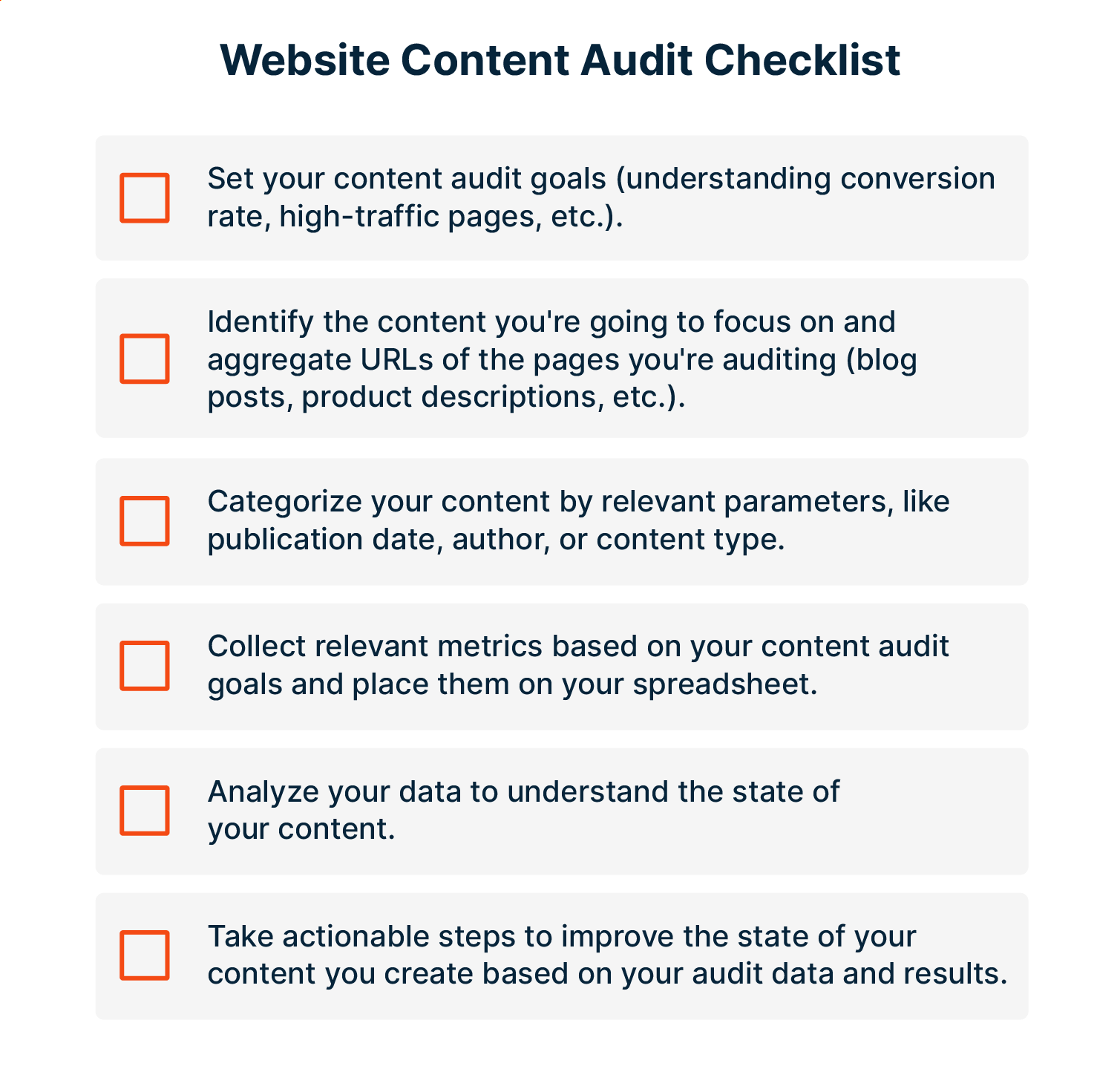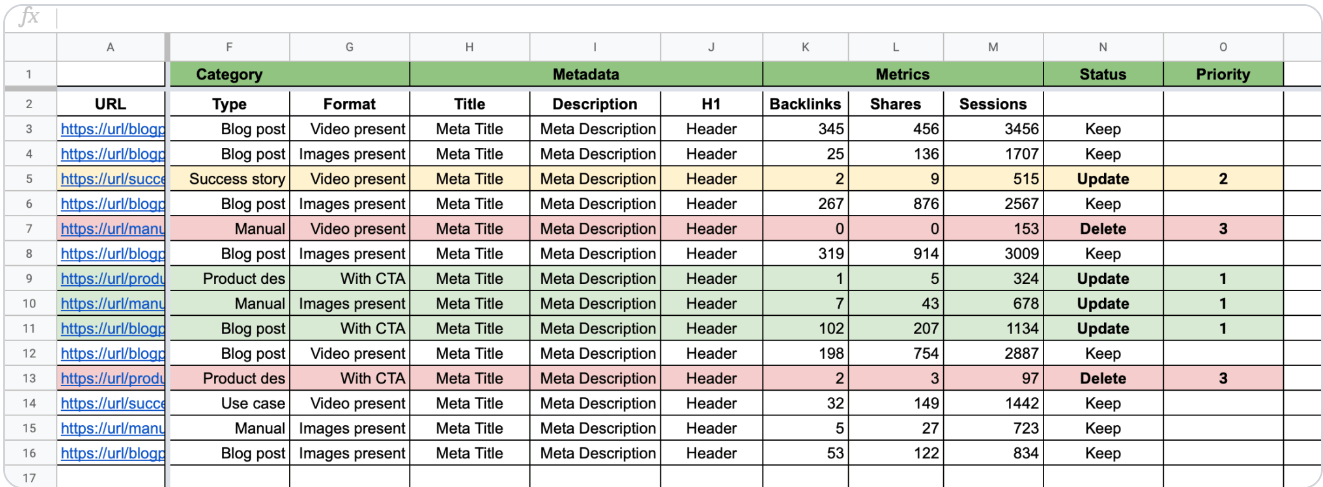Turn your content marketing into an evergreen content strategy through regular audits. Evergreen content is digital media that’s always fresh and relevant. It has the latest information and current links and uses modern marketing techniques. Your content audit will identify what digital assets need updating and optimizing so you’re getting the best possible results from your marketing investment.
Explore the benefits of a content audit and the seven steps to perform one on your website.
Key Takeaways:
- A content audit analyzes your website content to look for missing or outdated content
- Perform a content audit two to four times a year
- Focus on one goal for each audit to avoid getting overwhelmed with data and metrics
🤫 PS: Looking for pricing on custom Tech content? Get a price list here
What Is a Content Audit?
A content audit analyzes all your website content as quality control to ensure your content is fully optimized.
When you perform a content audit, you collect all your online media to create an updated inventory of your pages, landing pages, blog posts, and other online content. You also identify potential issues, like broken links, outdated posts, or poorly performing content.
A full content audit can take several days to complete. If you’re performing it manually, it may even take weeks, depending on how much content you’re working with.
What Is the Purpose of a Content Audit?
You should perform website audits two to four times yearly, depending on your company’s size and how much content you create each month.
Some of the benefits of performing a content audit include:
- Generating data for optimizing future content
- Understanding what performs best
- Identifying new opportunities to create content
- Filling in content gaps and missed opportunities
- Updating old content to improve its performance
- Rewriting outdated or poorly written content
- Deleting unused or outdated content
Keeping your content fresh and updated will increase your website traffic as your content will continue ranking well and driving new visitors to your website. You also improve your website’s authority as the information your visitors see is always accurate, and they don’t run into broken links or missing pages.
If your website content isn’t optimized, it can negatively impact the consumer experience. For example, page load times between zero and four seconds are ideal for the highest conversion rate. However, after five seconds, your traffic will start leaving the page, negatively impacting your conversion rate. Poorly optimized media can cause slow load times.
7 Steps to Perform a Content Audit
Use these seven steps for auditing your website content and the following content audit checklist.

Step 1: Establish Your Goals
There are dozens of areas you can analyze and audit on your website. If you tried to cover it all at once, you would spend months out of your year performing content audits. Establishing goals keeps you focused on the essential tasks and breaks up an otherwise overwhelming job into smaller steps you can complete each quarter.
What do you want to get out of your content audit?
Some examples of content audit goals include:
- Improving your SEO
- Increasing your audience engagement
- Increasing your conversions
For example, if you want to improve your SEO ranking, you’ll look for outdated content to refresh, broken links to fix, and poorly ranking pages to optimize.
Step 2: Choose your Metrics
Your content metrics are what you use to measure your content’s success. They’ll tell you what content you need to update and which pieces are performing well in reaching your goal.
Here are some examples of metrics you can use based on the previous goals:
- Improving your SEO: Traffic, backlinks, keyword ranking
- Increasing your audience engagement: Comments, likes, shares, link clicks
- Increasing your conversions: Number of leads, conversion rate, sales, ROI
Step 3: Collect Your Content
Now you’re ready to start compiling your content into one location where you can analyze it. If you’re new to content marketing for tech companies, you could audit your entire website at once. However, most content marketers already have significant content on their websites. Sorting through all your content at once might not be the best strategy.
Instead, consider choosing only a small portion of content. For instance, you might decide to review your blog posts. Then, depending on how many blog posts you have, you can segment your content further by auditing content between specific dates.
Collect the content you choose in a spreadsheet. You can import your content’s information directly into a list using content auditing software like SEMrush or HubSpot. Otherwise, you’ll need to add your content manually to a spreadsheet from your website’s site map.
Step 4: Fill in Asset Data
Once you choose the content to analyze, fill in your spreadsheet with the necessary details about that content. The data you include depends on your goal and selected metrics. For example, if your goal is to increase conversions, add data matching your goal’s metrics.
While you can gather this information manually from your website analytic reports, audit software will make this process much faster by importing those fields for you.
Here are a few examples of fields to create and fill in your content audit report:
- Title
- Target keyword
- Meta description
- Page headings
- Inbound and outbound links
- Images and videos
- Last update
- Page visits
- Word count
- Type of content
- Topic
- Tags
- Author

Image from SEMrush
Step 5: Categorize Your Content
To break your content into easy-to-digest pieces, group your content into categories that will make the auditing process more manageable. For example, you might group your content by date, type, format, or author.
Step 6: Analyze Your Content
There’s no established process for analyzing content, so this step depends on what your goal is. While you might want to explore every detail of your content, remain focused on the objective to keep your audit on track and ensure you perform the essential tasks and updates.
Some content audit questions you can ask include:
- What’s missing? (missing topics, missing information, missing pages)
- What’s not performing well?
- What’s performing very well?
- Is anything outdated?
As you look through your content, mark each asset with a ranking or action. For example, you might rank your content with a score between one and five on how well it’s performing. Then you can go back and focus on those with the lowest ranking.
Step 7: Create an Action Plan
You’re ready to finalize your content audit. Take your rankings or other system and choose the best action for addressing poor-performing content.
For example, you can assign an action to each ranking, like keeping content ranking two or higher, updating content ranked three, rewriting content ranked four, and deleting content ranked five.
Focus on the lowest performing content and go through each piece with your content marketing team to ensure it meets your latest marketing standards.
Update Your Content with Modern Media
ActualTech Media can help give your content a complete facelift with updated designs, interactive features, and modern marketing techniques. In addition, our content reports provide the information you need for your next content audit.
Contact us to learn more about our content creation services.